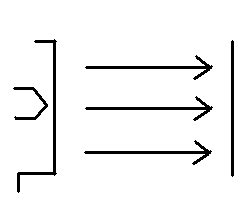 |
Vacuum tubes are not new technology, but they can still teach us volumes about the behavior of electrons. In my project, I studied two types of electron behavior. I used common vacuum tubes, easily obtainable and inexpensive. My goal was to observe, record and understand these electrical phenomena. The first behavior I studied was saturation, and the second was secondary emission. I was able to observe both behaviors and gain an understanding of the underlying reasons for them.
Vacuum tubes are complicated devices. Small changes in their construction or the input have measurable effects on their output. The basic idea of the tube is a nearly evacuated chamber containing a heater, a cathode for emitting electrons and an anode for collecting electrons (also called the plate). In between those two elements different tubes have different components. The cathode is typically a nickel sleeve, coated to increase its electron emission ability. The heater heats the cathode until the electrons start to boil off. The plate is operated at a positive voltage compared to the cathode so that the electrons leaving the cathode are attracted and pulled across the vacuum. (Reich)
 |
The simplest tube design is the diode. It consists of only a heater, cathode and plate. In my research I used one diode, the 6X4 tube. This tube has some interesting properties, but is not as useful as some of the more complicated designs.
The next step up is the triode. In a triode, there is another element added in between the cathode and plate called the control grid. It is a metal grid, mostly open space, placed very close to the cathode. This grid creates an electric field against the field created by the plate in between the grid and the cathode. The electron behavior in between the cathode and control grid is then influenced by the net electric field between them. I did not use any triodes in my research.
The advantage of adding the control grid is the amplifying properties. Since the electric field created between two elements is directly proportional to the potential difference between them, and indirectly proportional to the distance between them, a small potential difference across the control grid can created a much larger field than the same potential across the plate. That means that the electrons at the cathode are pushed or pulled by the field from the control grid and not the plate. They are not influenced by the plate until they get passed the control grid. Since the potential difference is a state function, the inserted control grid will not affect the final point of the electrons sticking to the plate, but only the number leaving the plate. That way, by applying a signal to the control grid, you can control how many electrons leave the plate, and then the final voltage output since it is directly proportional to the number of electrons passing through, better known as the current. Again, the current is directly proportional to the potential difference, and the potential difference is indirectly proportional to the distance between the elements, so the alternating potential at the control grid produces an alternating potential at opposite direction and much greater magnitude at the plate.
The triode has some inherent problems, the worst being feedback. As the control grid affects the plate, the plate works the same way to affect the control grid. The two elements act on each other in a continuous loop and can cause terrible problems to the operation of the tube. In order to break this cycle, the next tube inserts a fourth element.
With two grids, the control grid and the screen grid, the tube is called a tetrode. The screen grid is also placed close to the cathode, but on the other side of the control grid. I ran many of the tubes I used as tetrodes by connecting the third screen, discussed later, and the screen grid together so that they will act as one grid. A large potential is placed across the screen grid resulting in an electric field in the same direction as the field produced by the plate. Then, with an increase in the control grid potential, the resultant net field between the control grid and the cathode will be determined by the control grid and not much affected by the plate because the potential is so much higher there than across the plate. This design virtually eliminates feedback.
Many tubes have a third grid, the suppressor grid. Besides the 6X4, all of the tubes I used were designed with three grids. This design is called a pentode.